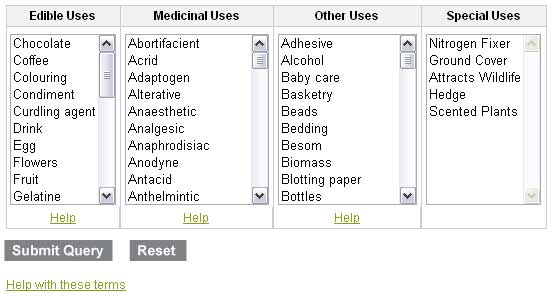There are a number of different ways of finding information from the database.
Given below are a number of different scenarios:
1. I know the Latin name and want to find more information on the plant
If you know the Latin name and have it's correct spelling enter the name in the Search for name

2. I think I know the Latin name but I'm not completely sure if the spelling is correct
If you are unclear how to spell the Latin name you can put part of the word into the Search For Name box (shown above). If want to find Aloe Vera for example but may be unsure on the spelling type the letters you know are correct. For example type 'A' will give you all the plants beginning with the 'A' letter. Type 'Al', will give you all the plants that begin with 'Al'. Type 'Alo', will give you all the plants beginning with 'Alo'..and so on. You can also type Aloe which will give you all the different species (types) of Aloe.
You can also search for a plant by using the first letter in the Browse section

For Both the Latin and Common names you can look for a plant by its first letter. For example, to find Aloe, click on the 'A' in Latin names shown above in the image.
3. I know the common name and want to find more information on the plant
When looking for a common name you need to be careful that you do not choose the wrong plant. Different plants can have the same common name which can lead to misidentification. To find a common name the process is the same as for a Latin name as described in 1. and 2. above.
4. I'm interested in a particular family of plants.
If you want to find information on a plant family you can use the BROWSE facility shown in 2. above. Just click on the Family link.
5. I'm looking for a plant for a particular habitat.
To search for a habitat use the Habitat link in the Browse section shown in 2. above . This link will take you to the habitat page where there are links to a number of other pages describing different habitats (for example, ponds, lawns, and hedges). Here you will also find a range of habitats that are linked to plants in the database for example: woodland gardens, meadows, and ponds.
You can also Search for plants in a particular habitat by using the SEARCH FOR KEYWORD towards the top of the search page.

The PROPERTIES option towards the bottom of the search page can also help you choose plants for a type of location. For example: a shady spot with clay soil


6. I'm interested in medicinal plants especially Homeopathy and Aromatherapy medicines.
You can search for the Keywords: Homeopathy, Aromatherapy, Bach (flower remedies), and Alternative in the Search Keyword shown in 5. above.
There are also links to the database for Alternative medicines from the Medicinal Uses page. This page will help you find all the plants that have been rated for different alternative and complementary medicinal uses.
You can also search for particular medical uses in the PLANT USES section of the search page:

If you want to know what the terms mean you can either click on the HELP link below each column or click on the link Help with these terms below the PLANT USES box.
7. I'm looking for a plant to help me with a particular complaint.
Searching for this information will be similar to the method used in 6. above. There are also links to the database for medicinal uses see the Medicinal Uses page. This page will help you find all the plants that have been rated for different alternative and complementary medicinal uses.
The medicinal uses fall under the headings: Bacteria, Viruses, Fungi and parasites, Stings, Bones, Cancer, Chest and Lungs, Ear, Nose and Throat and Eyes, Fevers, General Well Being, Heart and Blood, Infectious Diseases, Liver, Kidneys, and other internal bits, Other medicinal uses, Pain Relief, Sex and Reproduction, Skin, Hands and Feet, Stomach, Treatment of Wounds and Bruises, Whole Body.
8. How do I find other uses of plants apart from medicinal or edible uses?
You can find other uses of plants in a number of ways.
(i) On the main search page go to the Plant Uses section and scroll down the other uses column until you find the use you are looking for (see the image in 6. above).
(ii) Have a look at the Other Uses page. Here you will find interesting articles (links to other pages) on: alternative lighting, fibre plants, soap plants, and vegetable oils.
You will also find a number of easy search links to the database. These fall under the headings: Building Materials, Clothing, Dyes, paints, inks and paper, Fertilisers, Fire and lighting, In the bathroom, In the Garden, In the home, In the kitchen, Pesticides, and Woodwork and other crafts.
(iii) You can do a Key Word search for the use you are looking for. The keyword search is limited so if you can find what you want it may still be worth checking out the options in (i) and (ii) above.
9. I'm looking for plants but I'm overwhelmed by the choices!
When you consider your climate, soil and local conditions you will probably find there are far fewer choices than you originally thought. Have a look at the page Before You Start to get a better idea on how to choose plants